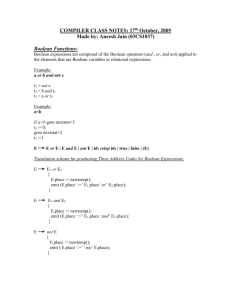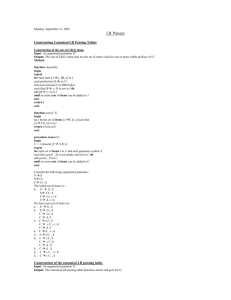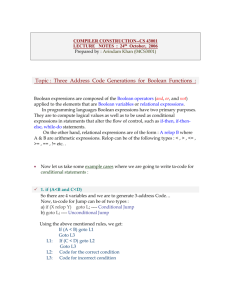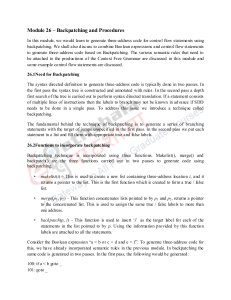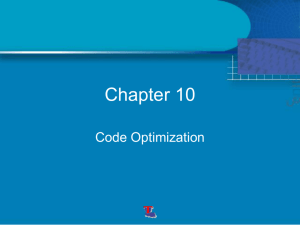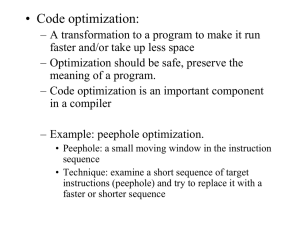Backpatching in Compiler Design: Intermediate Code Generation
advertisement
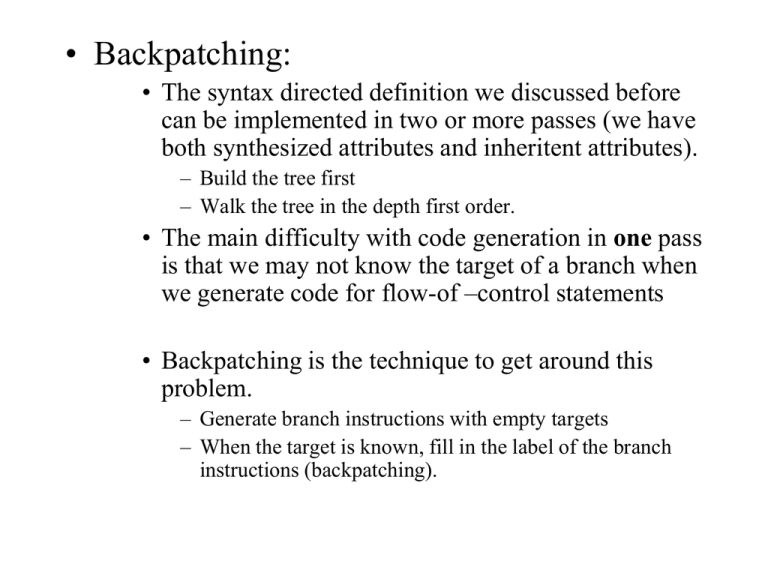
• Backpatching:
• The syntax directed definition we discussed before
can be implemented in two or more passes (we have
both synthesized attributes and inheritent attributes).
– Build the tree first
– Walk the tree in the depth first order.
• The main difficulty with code generation in one pass
is that we may not know the target of a branch when
we generate code for flow-of –control statements
• Backpatching is the technique to get around this
problem.
– Generate branch instructions with empty targets
– When the target is known, fill in the label of the branch
instructions (backpatching).
• Example: generate intermediate code for the
following program segment
If (a < b) then I := I+1 else j:= I+1
100:
101:
102:
103:
104:
105:
106:
107:
if a < b then goto ???
goto ???
t1 = I+1
I = t1
goto ???
t1 = I+1
j = t1
• Boolean expressions
E->E1 or M E2
E->E1 and M E2
E-> not E1
E-> ( E1 )
E->id1 relop id2
E->true
E->false
M->
• E has two attributes truelist and falselist to store the
list of goto instructions with empty destinations.
– Truelist: goto TRUELABEL
– Falselist: goto FALSELABLE
• M.quad: the number for current instruction
• Makelist(quad): create a list.
E->E1 or M E2 { backpatch(E1.falselist, M.qual);
E.truelist = merge(E1.truelist, E2.truelist); E.falselist = E2.falselist;}
E->E1 and M E2 {backpatch(E1.truelist, M.qual);
E.truelist = E2.truelist; E.falselist = merge(E1.truelist, E2.truelist);}
E-> not E1 {E.truelist = E1.falselist, E.falselist = E1.truelist;}
E-> ( E1 ) {E.truelist = E1.truelist; E.falselist = E1.falselist;}
E->id1 relop id2 {E.truelist = makelist(nextquad);
E.falselist = makelist(nextquad+1);
emit(‘if’ id1.place relop.op id2.place ‘goto ???’);
emit(‘goto ???’);
}
E->true {E.truelist = makelist(nextquad); emit(‘goto ???’);}
E->false {E.falselist = makelist(nextquad);emit(‘goto ???’);}
M-> {M.quad = nextquad;}
Example: generating code using one pass LR parser
a < b or (c < d and e < f)
100: If (a < b) goto ???
101: goto ???
102: if c < d goto ???
103: goto ???
104: If e < f goto ???
105: goto ???
•
Flow of control statements
S -> if E then S1
S -> if E then S1 else S2
S -> while E do S1
S-> begin L end
S-> A
L->L; S
L->S
•
•
Attributes: E.truelist, E.falselist
S.nextlist: goto statements to the next instruction after this
statement.
S -> if E then M S1 { backpatch(E.truelist, M.quad);
S.nextlist = merge(E.falselist, S1.nextlist);}
S-> if E then M1 S1 N else M2 S2 {
backpatch(E.truelist, M1.quad); backpatch(E.falselist, M2.quad);
S.nextlist := merge(S1.nextlist, N.nextlist, S2.nextlist);}
S -> while M1 E do M2 S1 {backpatch(E.truelist, M2.quad);
Backpatch(S1.nextlist, M1.quad);S.nextlist = E.falselist;
Emit(‘goto ‘ M1.quad);}
S-> begin L end {S.nextlist = L.nextlist}
S-> A {S.nextlist = null;}
L->L; M S {backpatch(L1.nextlist, M.quad);L.nextlist = S.nextlist;}
L->S {L.nextlist = S.nextlist;}
N-> {N.nextlist = makelist(nextquad); emit(‘goto ???’);}
M-> {M.quad = nextquad;}
While (a < b or (c < d and e < f)) do
if c < d then
x:= y+z
else
x:= y-z
–
Procedure calls:
•
•
–
Must generate the calling sequence and returning
sequence.
Can be done either at the calling or at the called
procedure – depending on machine and OS.
A simplified example:
S->call id (Elist) {for each item p on queue do
emit(‘param’ p);
emit(‘call’ id.place);}
Elist->Elist1, E {append E.place to the end of the
queue;}
Elist->E {initialize queue to contain only E.place;}
